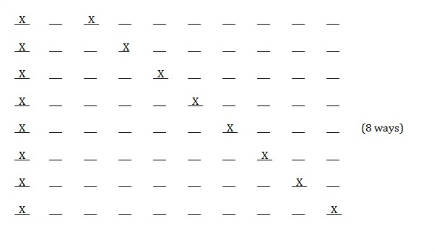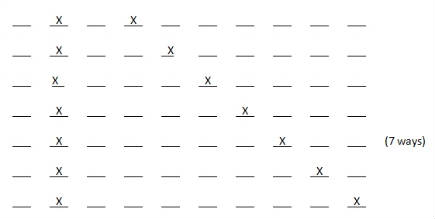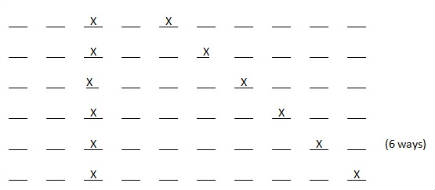Where Would You Sit in Your Neighborhood Café?
In a neighborhood café there are 10 seats in a row at the counter. In the morning, customers enter the café for their morning coffee. They don’t really want to have a conversation, so they prefer not to sit next to one another at the counter.
Two people enter the café when it opens. How many different ways can these two customers sit at the counter so that they are not next to each other?
Some Approaches:
In a neighborhood café, there are 10 seats in a row at the counter. In the morning, customers enter the café for their morning coffee. They don’t really want to have a conversation, so they prefer not to sit next to one another at the counter.
Two people enter the café when it opens. How many different ways can these two customers sit at the counter so that they are not next to each other?
Organizing the possibilities is an important strategy in solving the problem!
Suppose that the café counter has empty seats as shown below, except where an X indicates that a customer is sitting. The two customers could sit so that they have one space between them, or two, or even eight spaces between them (with one customer at each end of the counter). Would
the order in which the customers sit make a difference, or do we just want to focus on the positions when we count the number of ways in which they can sit? For now, let’s just focus on the positions; we can address the order later on. We must be systematic about our counting, or we will double count, or get
confused—so, one strategy that many students choose is to hold one person in a fixed seat, and move the other person into all the possible seats that have at least one space between them. For example, as shown below, we can count eight ways in which we can have a customer in the first seat on the left and the
other customer in another seat to the right, in a way that will preserve their morning privacy, with at least one space between them. You and your students can pursue this reasoning path by moving the “fixed” customer into the second seat, and counting the number of ways the other customer can be seated. Then you can
move the fixed customer into the third seat, and so on. It will help the students if they actually use objects, and move the objects in the spaces as they count in this manner.

My December message will provide more information about this Problem to Ponder. For now, think about the following extensions.
1. Suppose that three grouchy customers came in to the café first thing in the morning. How many ways could they seat themselves so none of them had to sit next to anyone?
2. What if the café had 12 seats instead of 10? Or had 15 seats? Or N seats?
3. What if the café had a circular counter with the ends joined. What would the grouchy customers do then?
4. How does the problem change if we are concerned about the order in which the customers are sitting?
Additional Approaches:
In last month’s column, we shared a strategy that many students zero in on when they make a systematic list of all the possible ways that two customers can sit at a 10-seat café counter without sitting next to one another. (Customers can be grouchy in the morning!) We began solving the
problem by considering only the seats that the customers occupy—not the order in which they sit. We saw that if one customer sits in the first seat on the left, the other customer has 8 choices of seats to maintain at least 1 space between them. Similarly, if the first customer sits in the second seat from the
left, the second customer has 7 choices of seats.

Continuing in this way, we can see that if the first customer sits in the third seat from the left, the second customer has only 6 choices (that we had not already listed when a customer was in the first seat).

And so forth. When we complete this process, altogether we have 8 + 7 + 6 + 5 + 4 + 3 + 2 + 1, or 36, ways, unordered, for the two customers to sit while avoiding sitting next to one another. To count the ordered ways, we must double this sum—since there are 2 different orderings for
each possible placement of the two people. Thus, counting the ordered ways gives us 72 possible ways in which the two customers can sit.
If the counter at the café has 12 seats instead of 10, then the two customers will have 10 + 9 + … + 1, or 45, possible unordered ways in which to sit, and 90 ordered ways.
In general, if the counter at a café has n seats, the number of different, unordered ways for the customers to sit will be the sum of the natural numbers from 1 to n – 2. Thus, the solution to the “grouchy customer” problem involves the sums of consecutive natural
numbers, and these sums are also known as the triangular numbers.
Extensions to Where
Would You Sit in Your Neighborhood Café?
Now, what if 3 customers enter the 10-seat café, and all of them are grouchy—everyone wants to sit at the counter without being next to anyone else. What then?
What about the general situation, with k grouchy customers at a counter with n seats?